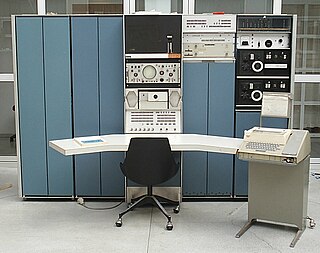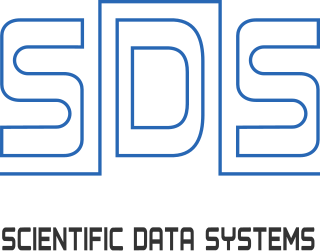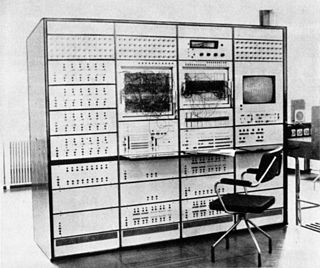Related Research Articles

Digital Equipment Corporation, using the trademark Digital, was a major American company in the computer industry from the 1960s to the 1990s. The company was co-founded by Ken Olsen and Harlan Anderson in 1957. Olsen was president until he was forced to resign in 1992, after the company had gone into precipitous decline.

The PDP-1 is the first computer in Digital Equipment Corporation's PDP series and was first produced in 1959. It is famous for being the most important computer in the creation of hacker culture at the Massachusetts Institute of Technology, Bolt, Beranek and Newman and elsewhere. The PDP-1 is the original hardware for playing history's first game on a minicomputer, Steve Russell's Spacewar!

In computing, time-sharing is the sharing of a computing resource among many tasks or users. It enables multi-tasking by a single user or enables multiple user sessions.

The PDP-7 is an 18-bit minicomputer produced by Digital Equipment Corporation as part of the PDP series. Introduced in 1964, shipped since 1965, it was the first to use their Flip-Chip technology. With a cost of US$72,000, it was cheap but powerful by the standards of the time. The PDP-7 is the third of Digital's 18-bit machines, with essentially the same instruction set architecture as the PDP-4 and the PDP-9.

A portable computer is a computer designed to be easily moved from one place to another, as opposed to those designed to remain stationary at a single location such as desktops and workstations. These computers usually include a display and keyboard that are directly connected to the main case, all sharing a single power plug together, much like later desktop computers called all-in-ones (AIO) that integrate the system's internal components into the same case as the display. In modern usage, a portable computer usually refers to a very light and compact personal computer such as a laptop, miniature or pocket-sized computer, while touchscreen-based handheld ("palmtop") devices such as tablet, phablet and smartphone are called mobile devices instead.

Scientific Data Systems (SDS), was an American computer company founded in September 1961 by Max Palevsky, Arthur Rock and Robert Beck, veterans of Packard Bell Corporation and Bendix, along with eleven other computer scientists. SDS was an early adopter of integrated circuits in computer design and the first to employ silicon transistors. The company concentrated on larger scientific workload focused machines and sold many machines to NASA during the Space Race. Most machines were both fast and relatively low priced. The company was sold to Xerox in 1969, but dwindling sales due to the oil crisis of 1973–74 caused Xerox to close the division in 1975 at a loss of hundreds of millions of dollars. During the Xerox years the company was officially Xerox Data Systems (XDS), whose machines were the Xerox 500 series.

Hybrid computers are computers that exhibit features of analog computers and digital computers. The digital component normally serves as the controller and provides logical and numerical operations, while the analog component often serves as a solver of differential equations and other mathematically complex problems.

The LGP-30, standing for Librascope General Purpose and then Librascope General Precision, is an early off-the-shelf computer. It was manufactured by the Librascope company of Glendale, California, and sold and serviced by the Royal Precision Electronic Computer Company, a joint venture with the Royal McBee division of the Royal Typewriter Company. The LGP-30 was first manufactured in 1956, at a retail price of $47,000, equivalent to $510,000 in 2022.
Max Palevsky was an American art collector, venture capitalist, philanthropist, and computer technology pioneer. He was known as a member of the Malibu Mafia – a group of wealthy American Jewish men who donated money to liberal and progressive causes and politicians.

The UNIVAC 1050 was a variable word-length decimal and binary computer. It was initially announced in May 1962 as an off-line input-output processor for larger UNIVAC systems.

The VAX-11 is a discontinued family of 32-bit superminicomputers, running the Virtual Address eXtension (VAX) instruction set architecture (ISA), developed and manufactured by Digital Equipment Corporation (DEC). Development began in 1976. In addition to being powerful machines in their own right, they also offer the additional ability to run user mode PDP-11 code, offering an upward compatible path for existing customers.
The gun data computer was a series of artillery computers used by the U.S. Army for coastal artillery, field artillery and anti-aircraft artillery applications. For antiaircraft applications they were used in conjunction with a director computer.
The Autonetics RECOMP II was a computer first introduced in 1958. It was made by the Autonetics division of North American Aviation.

Interdata, Inc., was a computer company, founded in 1966 by a former Electronic Associates engineer, Daniel Sinnott, and was based in Oceanport, New Jersey. The company produced a line of 16- and 32-bit minicomputers that were loosely based on the IBM 360 instruction set architecture but at a cheaper price. In 1974, it produced one of the first 32-bit minicomputers, the Interdata 7/32. The company then used the parallel processing approach, where multiple tasks were performed at the same time, making real-time computing a reality.

The MADDIDA was a special-purpose digital computer used for solving systems of ordinary differential equations. It was the first computer to represent bits using voltage levels and whose entire logic was specified in Boolean algebra. Invented by Floyd Steele, MADDIDA was developed at Northrop Aircraft Corporation between 1946 and 1949 to be used as a guidance system for the Snark missile. No guidance system, however, resulted from the work on the MADDIDA, and rather it was used for aeronautical research. In 1952, the MADDIDA became the world's top-selling commercial digital computer, six units having been sold.
Packard Bell Corporation was an American electronics manufacturer founded in 1933 by Herb Bell and Leon Packard. Initially they produced radios, but expanded into defense electronics during World War II. After the war, they began manufacturing other consumer electronics, including television sets. In 1957, the company became involved in the manufacture of scientific and military computers. Industrial conglomerate Teledyne Technologies acquired the business in 1968. In 1986, Israeli investors bought the name for a newly formed personal computer manufacturer, Packard Bell.
The PB286LP, released in 1989, was Packard Bell's first laptop computer. The laptop featured an 80C286 processor clocked at 12 MHz and 1 MB of RAM, along with a single ISA expansion slot. Packard Bell released the PB286LP in 1989 among a slew of products aimed at the corporate market. Technology writers gave it mostly positive reviews, although some noted its 16-lb weight as hefty and its monochrome LCD as somewhat flawed. Originally only capable of CGA-mode graphics, the laptop was updated in 1990 to support VGA. Packard Bell discontinued the PB286LP in 1991, in favor of more-compact, notebook-sized computers.
References
- 1 2 3 Funderburk, B. J. (1 Jan 1968). "Automation in Saturn 1 first stage checkout": 3, 6.
{{cite journal}}: Cite journal requires|journal=(help) - 1 2 Beck 1960, p. 283-284.
- ↑ Computers and Automation & Aug 1960, p. 1B (9).
- 1 2 "Packard Bell Computer Corporation, PB250" (PDF). Digital Computer Newsletter. Vol. 12, no. 3. Office of Naval Research. July 1960. p. 6–7. Retrieved 1 June 2022.
- 1 2 3 4 Weik, Martin H. (Mar 1961). "PACKARD BELL 250". ed-thelen.org. A Third Survey of Domestic Electronic Digital Computing Systems.
For applications where power failures and resultant loss of memory cannot be tolerated a battery power supply is available which will operate the computer for several hours without line power.
- ↑ AUERBACH Standard EDP Reports & vol. 7, pp. 250.
- ↑ bitsavers, PBC1000r4_PB250techManVol1.pdf, p. 1-3 (13).
- ↑ "Packard Bell, Bailey Meter Sign Agreement". Los Angeles Times. Los Angeles. April 15, 1960.
Max Palevsky, Packard Bell Computer vice president, said power plants in the electric industry provide one of the most promising markets for digital computers.
- ↑ Center, Smithsonian Lemelson (23 July 2014). "Computer Oral History Collection, 1969–1973, 1977: Harry Huskey and Mrs. Huskey". Lemelson Center for the Study of Invention and Innovation. AC0196_husk730419.pdf, pp. 15, 17, 19, 24.
- 1 2 3 Center, Smithsonian Lemelson (23 July 2014). "Computer Oral History Collection, 1969–1973, 1977: Max Palevsky". Lemelson Center for the Study of Invention and Innovation. AC0196_pale730215.pdf, pp. 4-5, 10-11.
- 1 2 Palevsky, Max oral history | 102657969 | Computer History Museum. 29 August 2006. pp. 11, 14, 19.
{{cite book}}:|website=ignored (help) - ↑ Weik, Martin H. (Jan 1964). "TRICE". ed-thelen.org. A Fourth Survey of Domestic Electronic Digital Computing Systems.
- ↑ Beck 1960, p. 285.
- ↑ Beck 1960, p. 287.
- ↑ Kaisler 2017, pp. 305, 309.
- 1 2 Computers and Automation & Sep 1963.
- ↑
- AUERBACH Standard EDP Reports & vol. 7 , pp. 187–190, 199–200, 219
- bitsavers , SP-147_PB-250_RefMan.pdf , pp. 19-23
- bitsavers , PBC1002r1_PB250techManVol2.pdf , pp. 1-4 – 1-9 (16-18)
- bitsavers , PBC1004r1_PB250pgmRef_Mar61.pdf , pp. 4-1 – 4-7 (99-105)
- ↑ "Electronic Operations". Electronics Industries (2): 199. Feb 1961.
A battery-operated electronic computer, PB 250, has been shown by Packard Bell Computer Div., Packard Bell Electronics. In normal operation, it operates from a battery trickle charged from a 115-v. power line. If 115-v. input is interrupted, computer can continue operating for more than 1 hr.
- ↑ "BATTERY OPERATED COMPUTER" (PDF). Computers and Automation. 10 (2): 1B (17). Feb 1961. Retrieved 2020-09-05.
For the first time, we believe, an electronic computer can operate entirely from a battery power supply.
- Elliot 802 was an earlier computer with a battery:
- "Elliott 800 series and 503: 1957 onwards – Systems Architecture". www.ourcomputerheritage.org. p. 2, 4.
- Elliot 802 was an earlier computer with a battery:
- ↑ AUERBACH Standard EDP Reports & vol. 7, pp. 170, 215–216, 227–228, 233–234.
- ↑ AUERBACH Standard EDP Reports & vol. 7, pp. 170, 213, 223–225, 235–237.
- ↑ AUERBACH Standard EDP Reports & vol. 7, pp. 170, 217, 229–231, 241–242.
- ↑ AUERBACH Standard EDP Reports & vol. 7 , pp. 239
- bitsavers , PBC1004r1_PB250pgmRef_Mar61.pdf , pp. 129-155
- ↑ Computers and Automation & Jun 1963, p. 82.
- ↑ Fortran II for the Raytheon 250 Computer.
- ↑ Beene, J.L.; Rankin, W.D. (1 October 1964). "Reactor experimentation and the Packard-Bell computer" (Submitted manuscript). Office of Scientific and Technical Information (OSTI). doi:10.2172/4228429. S2CID 108792184.
{{cite journal}}: Cite journal requires|journal=(help) - ↑ Programming manual for TRICE and other material on DDA's 2nd edition | 102664334 | Computer History Museum. 3 May 1960.
{{cite book}}:|website=ignored (help) - ↑ "Packard Bell Computer | Selling the Computer Revolution | Computer History Museum". www.computerhistory.org. HYCOMP 250---The first desk top hybrid analog/digital computing system.
- ↑ "across the editor's desk: COMPUTING AND DATA PROCESSING NEWSLETTER – SPERRY ORDERS TWO NUCLEAR SUB TRAINING SYSTEMS" (PDF). Computers and Automation. XII (5): 44. May 1963. Retrieved 2020-09-05.
- ↑ Advances in Instrumentation: Proceedings of the ISA International Conference and Exhibit. Vol. 38. Instrument Society of America. 1983. p. 244. ISBN 9780876647806.
- ↑ NIEUWBOURG, Philippe. "SETI Calculateur PB 250" [SETI Calculator PB 250]. Le blog de l'actualité du musée de l'informatique (in French). Google translation.
{{cite web}}: External link in|others= - ↑ "Chemical Plant Puts Computer on Wheels". Control Engineering. Vol. 8. Technical Publishing Company. 1961. p. 29.
- ↑ Business Automation. Vol. 8. Hitchcock Publishing Company. 1962. p. 48.
- ↑ "ACROSS THE EDITOR'S DESK: New Firms, Divisions, and Mergers – ON-CALL DATA VANS FOR HIRE" (PDF). Computers and Automation. XI (7): 28. Jul 1962. Retrieved 2020-09-05.